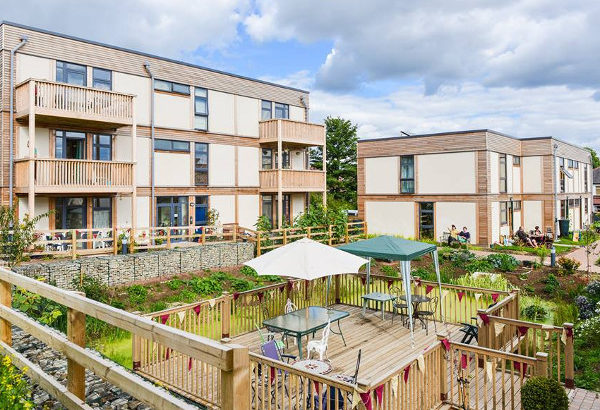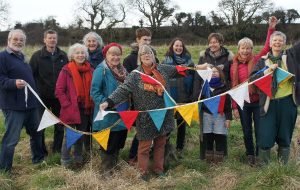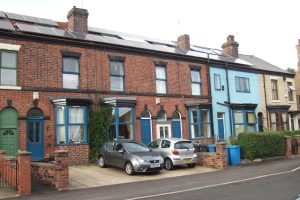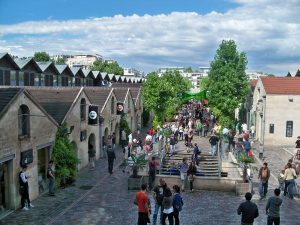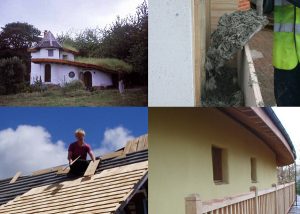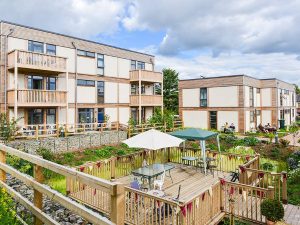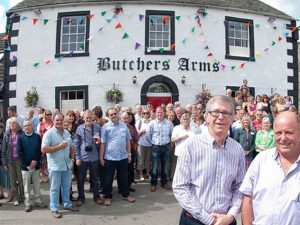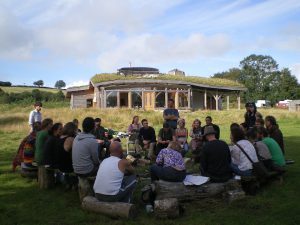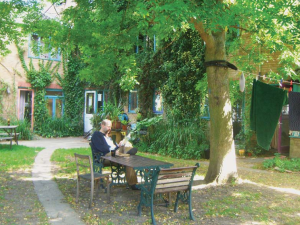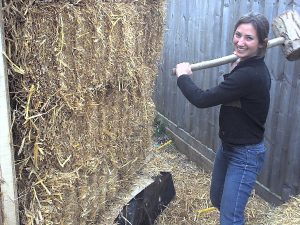Today we’re talking with Paul Chatterton, of LILAC community in Leeds about community-led housing and mutual home ownership societies.
I often wonder how to start to talk with people I don’t know – where to pitch the conversation. But I watched a speech of yours on a YouTube video – everyday action, or something like that (NB: it’s here), and I loved it. I think we’re on exactly the same page.
So you went to live with the Zapatistas? That must have been very interesting.
Yes – 2 years of solidarity work. I stopped being an academic, and dug holes in the jungle for 2 years, and carried bags of cement. The thing I liked about that was that I came back thinking ‘what does it mean to be a Zapatista in the UK?’. That was a great sentiment I brought home. I think it’s about laying down infrastructure / building alternatives, because that’s what they wanted us to do – i.e. not to hang out with them in Mexico, but to go home and do it.
Yes. So I’m coming from an environmental perspective. I’ve worked in the environment field for 25 years. There’s a crash coming, for a combination of reasons, but it seems unavoidable now. Everybody is saying the same as you – let’s build infrastructure, let’s build a network of whatever you want to call it – co-operative housing, co-operative employment, permaculture networks, transition networks – to catch people, basically, when the crash happens, to mitigate the effects and push it back a bit. But things need to happen on the ground, which is why what you’re doing is so interesting. I’m very interested in the mutual home ownership society model. Where did the idea come from?
It was a coming together of lots of things the co-operative sector had been doing for decades. We wanted to know how to service this bit in the middle called ‘intermediate housing’. So, not for people on social rental housing, provided by the state, and not owner occupation / mortgages, but this big bit in the middle. The question was – how do we get together democratically to organise our own community, along the lines of self-management? But to build in economic equality. So the key thing with MHOS – mutual home ownership society – is that the value of your home is linked to wages, and not local house prices. It’s more like owning a car than a house. If you de-commodify your asset, you jump out of the housing market, into a social market, which is really exciting. Everyone pays the same percentage – 35% of their income. The issue of parity is very important.
So if you get promotion, or a better-paid job, and your income suddenly doubles, then your housing costs double as well?
Well you just buy a bigger stake in your housing more quickly. And then when you’ve paid off all the equity in your house, that you’ve been allocated, you then only pay 10% as a service charge. You’ll just get to the end of your 35% payment plan quicker if your salary goes up. But also, with the higher earners, we ask them to take on a slightly higher proportion of the build cost of their homes – which is really exciting. So we can take on maybe 110 or 120% of the build cost of their home, which means that other people (on lower incomes) can take on 80 or 90%. So there’s a levelling device there.
So it’s about equality as well as co-operative ownership. So let’s give people a bit of context. You’re talking about LILAC in Leeds, which stands for Low-impact Living Affordable Community. And that’s 22 homes – is that right?
20 homes, with a common house, so there’s about 50 of us who live there, with 13 kids. We started 5 years ago. The homes are built from straw, timber and lime, so out of the box, we’re a carbon sequestering community, and the big thing is that just by the way we live, rather than building with brick and cement, which is carbon-emitting, we’re carbon sequestering – which means we’re a positive contributor in the climate change crisis. And also, the adjustments we’ve made to the way we live, especially through the sharing economy at LILAC, reducing our community footprint. So car sharing, car pooling, cooking together – that kind of thing. We don’t all have to have a lawn-mower, washing machine etc. – we share this kind of stuff.
So it ticks a lot of boxes – sustainability, co-operative ownership, material equality.
What the scientific community is talking about now is how do we hold temperature increases below 1.5 degrees. That’s the big challenge from the Paris agreement. What I’m saying now is that LILAC is a 1.5 degree compliant community. We’re living within the boundaries of our global biosphere. So how do we replicate it on that basis? We need an urgent and rapid transition to hold to that 1.5 degree limit.
It’s a bit like the one-planet development idea in Wales, where you pledge to live with a one-planet footprint.
Yes, but it’s a bit more than that, isn’t it. We probably need a less-than-one-planet footprint to make up for our previous ‘sins’. So not just to get back to a base line, but also to take it further. We’ve got more of a catch-up to do.
The reason I’m interested in what you’re doing is that it’s about land ownership, not just building technology, although that’s very interesting too, obviously. But it’s land values that have produced the housing crisis, isn’t it? It’s not the price of the buildings themselves. So any model that challenges that has to be very interesting.
Yes, we’ve got massive market dysfunction, where we’ve got volume builders land-banking – they’re building things on sites that happen to be called houses, but what they really are is a device to extract as much money as possible for shareholders. It’s a completely defunct model. What we need is land tax reform, community land reform, where vast tracts of land are put back into community ownership. Because it’s the communities that can build in community wealth. We know how to build community wealth, so that money circulates within the local economy. That’s the key thing. That’s what co-ops and community land trusts can do – recycle community wealth.
So what was your role in starting LILAC?
I was one of the co-founders. About 6 of us had the original idea. We then put a membership call out, and we grew from that initial 6 up to about 50-odd people. And I live there now. I’ve lived there for about 5 years.
It must make you feel really good to see something real, in existence, not just an abstract idea.
It does, and we still have dozens of people coming through the doors who want to see what we’ve done, because there’s nothing like a good example. People are thinking about how to tackle all these big problems, and our answer is: think big, start something now, and build from there. Just try some stuff. A lot of it is about prototyping – learning, moving on, developing. We’re still a learning community. We haven’t found some sort of end point.
And it’s not that some of the houses are affordable – they all are, aren’t they?
Yes, they’re all leasehold, so you get a lease from the society, and once a month, the whole society makes a mortgage payment to the bank.
So everyone is a home owner rather than a renter?
That’s right. Everyone gets a permanent lease, and you pay a third of your income, which pays for the price of your home, but also an 80% reduction in energy bills, because we’ve got very high-insulated houses – so you get quite a lot for your 35%.
What happens if you end up on benefits? Is there a certain level you pay on benefits?
It doesn’t work on benefits, because you’re not allowed to accrue equity. We have to freeze your equity and put you on a tenancy. We’ve never had to do that though, because rather than being a housing association, where you might just get kicked out if you lose your job, we support you as a community. We’re a co-op and we’re good to our members.
Does a community land trust own the land, and the co-op looks after the buildings. Is that right?
In our case it doesn’t, but it could do. It was just that we didn’t have a CLT around when we set up our member co-op, so LILAC Co-operative Ltd. owns the land, as well as the buildings – which is great in a way, because we’re just a self-governing community, but we’re very outward-looking. But in an ideal world, there would be a community land trust in Leeds. Actually, we set up Leeds Community Homes to do this. Then they can start to replicate all these little co-ops, and own the land in perpetuity. That will be the exciting thing.
So you’re a registered housing co-op?
Yes.
So is the thing that’s new about the mutual home ownership society model the percentage of your income as payment? Is that the thing that’s new?
That’s right. The government says that you shouldn’t pay more than 35% of your income on housing – beyond that is unaffordable. So the unique thing is that it’s affordable in perpetuity, because it’s always 35%, and the big thing really is linking the value of your equity to local wages and not house prices. So rather than house prices going up rapidly, the cost of housing at LILAC stays level. If it’s linked to your wage, it never becomes unaffordable. The big problem in the UK is that house prices have grown to seven times wages on average. That’s the main issue – whereas in LILAC costs stay the same.
Do you have a waiting list?
Yes – we had one flat come up the other month, and we had 29 applications. So we could build another LILAC tomorrow – it’s just about getting the groups together, getting the land. There’s a massive appetite out there for people to live differently. But the issue is, we’re stuck with the volume builders and unscrupulous private landlords. We can do what we’re doing, but we want to start a whole movement, where people can do this for themselves.
So I’ve had a look at Stroud Cohousing, and I think the housing there has become unaffordable.
Yeah. They’re using a cohousing design, which is nice. They’re great people – I know them. But essentially, they’re private homes, so you can buy and sell them, and they let the market dictate the price of the houses. The initial resident will benefit from a particular build cost, but then the market dictates. So what we need is some kind of price cap. In a normal market, we need a re-sell covenant, that says that you can’t sell your house above a certain percentage increase in price. Otherwise, we’ll get creeping gentrification – eco housing just for the wealthy.
So I’m thinking about your model, and what will keep them affordable in perpetuity – it’s the fact that payments are 35% of your income. But could members decide to change that? Is there some sort of asset lock (or ‘principle lock’) on it?
When we bought the land from Leeds city council, there was a covenant on the land, that says that if we wound up the co-op and carpetbagged it, we’d have to dispose of the assets to a similar organisation – a social organisation. Sometimes co-ops get a bad name, because of carpetbagging, so we want to avoid that. And I think there’s new legislation that stops you doing that anyway. We need to see co-ops as a positive influence in society.
I used to live at Redfield Community – a housing co-op in Buckinghamshire, and they had an asset lock which said exactly that. It was bought for 70k in 1978, and now it’s worth millions, and there’s an asset lock that means that if it’s sold, the money would have to be used to buy more land and start a new community, or it would have to be given to an umbrella organisation in the co-operative world, which doesn’t allow the members to make any profit out of it if it’s sold, which is what the founders wanted.
So a mutual home ownership society (MHOS) – the thing that makes it different from a co-op or a community land trust is the income clause – is that what makes it a different model?
Well, you’re buying equity in your house, so you’re not just paying rent, without having a stake in your housing. Every time you pay your monthly member charge, you’re buying equity in your house, so you’re buying a bit of equity each month until you own all the equity in your home. So if you leave, you get that value repaid, and the incoming member has to buy that equity from you.
So I guess it keeps you on the housing ladder, if that’s where you want to be, but if you bought a house privately and sold it again, you’d be higher up the housing ladder. But because of LILAC’s model, is there a danger that people could fall behind over time – so the longer they stay there, the harder it is for them to get back on the housing ladder?
That’s been discussed a lot, but someone’s got to make a stand. Where are we going as a society? There have been lots of different experiments over the years, and actually, we get a much stronger social return than a financial return. We have a great life, and actually, what do you prioritise? Do you want to be part of the system in which buying a house is all about assets? We’ve put a line in the sand.
Good for you. So do members have to agree on new members – do they have to be checked out by existing members?
Yeah – like any membership organisation, we approve our members. People tend to be self-selecting, but we try to keep an eye on diversity. It’s all pretty positive.
I think people find the terminology difficult (meaning that I do). Where does cohousing fit into this? Is that the umbrella term? Is MHOS a type of cohousing?
Good question. It’s nice to explore this actually, because there are 5 key elements in the world of community-led housing. And we’re all of them in a way. The first is cohousing, which is really a design methodology, where you build in neighbourliness – how you lay out the community, and how people interact.
It’s the architecture rather than the ownership?
Yeah, it’s social architecture – you build in places where people are going to bump into each other. So that’s cohousing. Then you’ve got co-ops, which are a way to democratically self-manage via a co-operative structure. Then you’ve got the land trust bit – so the community land trust movement is the bit about the stewardship of land by communities, which is the really important third bit. The fourth part is the custom- and self-build movement – the people who say ‘we’re not going to let the volume builders do it, we’re going to do it ourselves’. Then the fifth part is the self-help movement – people who are retrofitting their neighbourhoods, and training themselves, empowering themselves with new skills to deliver our own housing. So those are the 5 parts together, which really excitingly make up this world, called community-led housing.
With the MHOS model, do the houses have to be together in the same place, or can they be scattered around a town?
We’re talking about little clusters of houses. For me, cohousing and co-ops are two sides of the same coin, so the cohousing co-ops that I’m really into will involve clusters of houses – around 20 or 30, which could then be federated around town. So you could have groupings that all federate together. That would be really powerful. People could move between them.
I like the idea of living closely with other people, but it’s difficult to achieve. I can see 3 main ways. A friend of mine in Sheffield is part of a group that bought 5 terraced houses in the same street, knocked all the fences down and made one big garden and put a big conservatory on the back, linking all the houses together. That’s difficult though, because you’ve got to find houses next to each other. Then there’s new build – like LILAC, which is difficult to do. LILAC took 6 years, didn’t it?
Yep.
And I think Bridport cohousing have just got their planning permission, but I think that’s been going on for more than 10 years. It takes a long time. Or, alternatively, you can find an old school or clinic or disused council building or something like that, and convert it – which is probably the easiest to do, but it’s difficult to find the properties. So how can we churn them out – how do we get more of them if all 3 of those options are difficult and/or time consuming?
Sure – but as the government is supporting us with this community-led housing start-up grant, that’s one big way we can do it. Plus things like city hubs. So Leeds Community Homes is a city hub for all this in Leeds. But the first one you mentioned – the retrofit cohousing – I think has the biggest potential, because most of the houses we’re going to have in future are already here. We’re not going to start bulldozing cities. So take any street in Britain, knock through all the gardens, push the cars to one end, make the middle house a common house – you could transform every street in Britain overnight, at actually quite a low cost. So it’s about retrofitting our streets.
How would you persuade all the people in the street to do it though?
That’s the interesting point. This isn’t a technical issue. It’s a behaviour change issue. It’s like anything – if we’re going to deal with climate change, community breakdown, we have all the technical answers. It’s a matter of winning hearts and minds – showing people that they would flourish by living in one way rather than another. We need more examples, so that people can visit those streets, and see that if everyone parks at one end, you can produce this massive ‘home zone’ which is safe for all the kids, or you can have street parties, an outside cinema. People can club together and buy the middle house – have a cinema, club house, meeting house. How else are we going to do it, other than by showing people it’s a better way to live.
I suppose if people already own their own homes, to try to get them to sign them over to some other scheme would be really difficult.
Yes. In Britain, we’re really tied into the idea of home ownership. The big problem is the financial value that people attach to their houses. That’s a sacred cow, and messing about with that is going to really scare people. There’s going to have to be other incentives, and actually it might increase the value of people’s homes. We need some studies, some research into what happens when the spaces around people’s homes change, to see if it increases the value of people’s homes. Look at places like Vauban in Freiburg – a completely car-free community. 80% of people cycle. Really beautiful green places, and the value of the homes there are quite high. We kind of know this instinctively. Good places to live – leafy suburbs, where there are fewer cars and more greenery, have higher-priced houses. We’re not talking about displacement and gentrification – we’re talking about a different way of valuing our neighbourhoods.
So there’s a UK MHOS network now, isn’t there? Is it a growing thing?
It’s a movement in its infancy. We’ve got interest all over Britain – Liverpool, Newcastle, Leeds, London, where people want to explore it. But I’d be happy to support any types of innovation in housing that are building community and co-operative ways of living.
What’s the main barrier, do you think?
Probably land, as well as changing hearts and minds. So – education that this could be a better way to live, but also releasing land. There’s lots of land tied up in corporate land banks, so it’s quite difficult to get hold of. We all live in communities where you see pockets of fenced-off derelict land, and you wonder who owns it, and why it’s been derelict for 10 years. So it’s about getting our hands on that land – getting asset transfers from councils etc.
What can people do if they think it’s for them? Where do they start, where do they get more information, where do they get stuck into something?
There are lots of sector support bodies, like the UK Community Land Trust Network, the UK Cohousing Network, the Confederation of Co-operative Housing, the National Custom & Self Build Portal. They can all offer support, examples etc. What we’re doing in Leeds, with Leeds community homes, is creating a hub for the city, a one-stop shop for people who want to do this. Similar examples are emerging in London, Birmingham and other cities, and we’re supporting them to create these hubs. So there’s plenty of support out there, plus there’s this community-led housing grant, which people can search for online and find out about. It’s a multi-million pound government grant which comes from a pot of money provided by Homes England. So this is the moment for community housing actually – there’s loads of support out there, and a bit of money.
We’ve got a few friends in London, and we all want to sell our houses and go and do something like this somewhere else. We don’t know where yet. Where do we go for advice, where’s our first port of call?
Well, you could look at LILAC’s website. We do 4 tours a year. We host people and show them what we’ve done. There’s my book on LILAC called Low-impact Living. Have a look at the resources on our website, plus Leeds Community Homes, plus the websites of the organisations I mentioned above. There’s going to be a portal for all these – a community-led housing portal. That’s coming soon. But all those websites I mentioned have great resources, and you’ll get a feel for the kind of things that have happened before. And drop us a line at Leeds Community Homes, because we can offer people advice. And in London, you’ve got places like London Community Land Trust, who’ve got a great website and resources.
So what are your ambitions next, and how can we help?
I’d like to see 1000 new community-led housing homes built over the next 10 years, and that’s what we’re trying to do with Leeds Community Homes. I’d like to support lots of little LILAC projects across the country. If people are really up for it, and they’ve got a focused group, I’m really up for helping people build little LILAC-type communities. I spend a lot of my time advising groups. We’re tackling the big issues of our time – climate change, austerity etc. – and so we’ve got to do this anyway. The next generation have to be living quite differently, so let’s do it this way.
I’m interviewing some really interesting people, and they’re all building networks of really great infrastructure on the ground, so I’m really interested in federating them, and so I’m trying to draw out things from what people are saying, to try to work out ways to federate.
That’s brilliant.
I’ll subscribe you to the blog, so you can see the other people I’m talking to, and you can have a listen and a read about what they’re saying as well.
I’ve pulled together loads of case studies. It’s Unlocking Sustainable Cities. It’s great to speak with you, and it’s really great that we’re building some momentum here.
Yeah. I’ll talk to you again, and I’d love to be kept up to speed with what you’re doing. Do you have a blog or a newsletter?
You can go to our website, and you can follow me on Twitter – PaulChatterton9. Then there’s Unlocking Sustainable Cites, as mentioned. If people send me examples, I’ll put them on the website as we go along. That’s a great way to build this. We also run a masters course here at Leeds Uni, where I work, on sustainable cities.
Good luck Paul, and very nice talking with you.
Thank you.
Highlights:
- It’s all about laying down infrastructure / building alternatives.
- The key thing with MHOS – mutual home ownership society – is that the value of your home is linked to wages, and not local house prices. It’s more like owning a car than a house. If you de-commodify your asset, you jump out of the housing market, into a social market, which is really exciting.
- There’s a massive appetite out there for people to live differently. But the issue is, we’re stuck with the volume builders and unscrupulous private landlords. We can do what we’re doing, but we want to start a whole movement, where people can do this for themselves.

